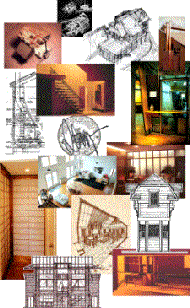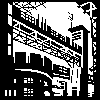Six steps
to building your dream
Guide to Architectural Services
Few people realize how complicated it is to build--that is until they
find themselves lost in the maze of design options, building codes, zoning
laws, contractors, and so on. No two building projects are exactly alike,
so there is no single, clear-cut path to follow.
The
Architect is the one professional who has the education, training,
experience, and vision to guide you through the entire design and construction
process, from helping you define what you want to build to helping you
define what you want to build to helping you get the most for your construction
dollar.
The
Architect sees the big picture. They don't just design four walls
and a roof--they create total environments, interiors and exteriors, that
satisfy functional needs and are exciting, dynamic spaces in which to work
and live.
Whether you are remodeling, adding on, or building from scratch,
the Architect can guide the way. Working with contractors and other construction
professionals, Architects will help you end up with a well-designed project
that meets your needs and works with your budget and time frame.
Architects
solve problems
Most building projects start with a want or need. "I need more file
space in my office." Or, "We've outgrown our house." But how does that
need or want get translated into square feet and three-dimensional space?
That is what
Architects do for you--solve problems in creative ways.
With our broad knowledge of design and construction, we show you alternatives
and options you might never think of on your own.
Need more room for your growing family? We show you how to enlarge
your home so you don't have to move. Not sure how fast your business is
going to grow? We design an office that meets your needs today and can
be adapted for tomorrow. Have a limited budget? We look for ways to make
your project cost effective.
Architects
can save you money
Architectural services are a wise investment for the money, not an added
cost to your project. Why?
Because a well-conceived project can be built more efficiently and
economically. We plan your project with you. As your ideas evolve, changes
can be made on paper--much less expensively than later on when construction
is underway. Thorough drawings also make it easier for the contractor to
accurately price and build your project.
Because energy efficient buildings save you money on fuel bills down
the road. We design a building to maximize heating from the sun and let
in natural light, thus reducing your heating, cooling, and electric bills
over time.
Because we work with your budget and help you select the appropriate
materials and workmanship at a fair price. We develop the drawings and
specifications to help you get bids for construction that are based on
your requirements.
Because we help you choose materials and finishes that are durable
as well as beautiful, saving on frequent maintenance and replacement costs.
We work to stay abreast of advances in roofing, brick work, floor tiling,
paint finishes, etc. Their familiarity with the full range of materials
enables them to suggest the appropriate materials for your project.
Because good design sells. A well-designed project has a higher resale
value. A well-designed store draws customers. A well-designed work environment
attracts employees and increases productivity.
Architects makes your life easier
Let's face it, building is a long process that is often messy and
disruptive, particularly if you are living or working in the space under
construction. The Architect looks out for your interests and tries to find ways
to make that process go smoothly.
When your project requires engineering or other design services,
the Architect coordinates this team of experts so you don't have to. We sort
out complex building codes and zoning laws. We help you find qualified
construction contractors based on your requirements. We visit the construction
site to help verify that the project is being built according to plans
and specifications. We review contractor payment requests to assure that
you pay for what is built and completed according to specification. We
prepare work change orders when necessary so that any change is recorded
and contracted accordingly.
The importance of understanding
the Architects' role
Your visit to our homepage is an excellent start to understanding
the role of the Architect. We believe that this is crucial in your decision
on the need to use Architectural services.
Once you understand this, think carefully about your building needs
and goals. Do you need more space? What activities will be housed in the
space? How much can you spend on the project? How will you finance it?
Where will it be located? Do you plan to do some of the work yourself?
Don't worry if you don't have all the answers. The Architect will help you clarify
your goals.
The initial meeting with
the
Architects and the concept
of team work
The initial meeting is crucial because it gives us both a chance
to meet each other and see who we are. It is our opportunity to begin a
strong design team with your project in mind. Remember, we will be working
with you for a long time and will potentially be starting a relationship
that can last much beyond one project. We want you to feel comfortable,
just like the way you feel with the other professionals in your life, your
doctor or dentist, your lawyer or accountant.
Figure on at least an hour for the meeting. It might take place at
our office -- helpful because you can see where the work will be done.
Or it could be held at your home or office -- helpful because we can learn
more about your project and needs -- whichever feels right. We may show
you slides or photographs of past work and describe how our firm's experience
and expertise will help you.
During the meeting don't be afraid to ask questions. How busy is
the firm? Does it have the capacity to take on your work? Who will handle
the job? What is our firm's design philosophy? How will we intend to approach
your project? We will discuss your budget to determine the range of fees
that we might anticipate for your project. If it is feasible we might take
you to one completed projects.
If, during the course of the discussion, there is something you don't
understand, ask us for clarification. Remember that we are there to make
things easy for you to understand, that we are there to represent you and
that we rely on teamwork as much as you do.
Team work
The best building projects are created when the client and
Architect
work together as a team. Take an active role. Don't delegate decision-making
to a spouse or business partner unless you are prepared to live with his
or her decisions.
Designing a building is an exciting, creative challenge. The process
can be fun, satisfying, and positive. It can also be hard work. If at any
time in the design process you are uncomfortable, discuss your concerns
with us. We don't want to control the project to the point that the building
is no longer yours. On the other hand, you may want to go away for a year
and come back to a completed project. But you also want to be careful not
to restrict us so much that you are not getting your money's worth in terms
of design creativity.
Our common ultimate goal
Ultimately, the goal of the initial meeting is to build trust and
obtain a feel for your project. Unlike buying a car or a new appliance,
you can't see the final product yet and test it out. The Architect provides
professional services, not a product. We are the ones who will provide
the judgment, technical expertise, and creative skills, at a reasonable
cost, to help your realize a project that fits your practical needs as
well as your dreams.
A word on
Architectural fee structures
Architectural
fee structures can be confusing to first-time clients.
There is no set fee for a particular type of project. Fees are established
in a number of ways, depending on the sort of project, and the amount and
nature of the services best suited to your unique needs.
Some projects are best done at hourly rates; others for a stipulated
sum per unit, based on what is to be built (for example, the number of
square feet, apartments, rooms, etc.). Sometimes Architects charge a fixed
fee; other times we charge a percentage of construction costs. It is appropriate
to discuss how we should expect to establish the fee on your project. We
may suggest a combination of the above methods. The basis for the fee,
the amount, and payment schedule are issues for us to work out together.
Therefore, its very important and helpful to know as much as we can
about the requirements of a particular project. Expenses are usually not
included since they can vary widely from copying and printing, travel expenses
or consultant costs. These expenses are added to regular invoices with
a modest multiplier to cover lost interest and overhead costs on these
types of expenditures.
Getting
agreements in writing
Once the fee is determined a services proposal will be prepared and
sent to you so that you will fully understand the services you will receive.
This will be your chance to review the proposal and make changes as they
are required.
When the decision is made to move ahead with the job, the terms of
the agreement on the scope of work, services, schedule, construction budget,
and compensation. This written agreement can take many forms. Architects have a variety of standard contract forms which are used industrywide for
all types of projects. The agreement is signed by both parties, and the
job usually begins with a modest retainer to carry the start-up operation
costs.
Six basic steps toward building
your dream
Design and construction projects involve several steps. Typically, projects
go through the following six phases. However, on some projects, several
of these steps may be combined; on others there may be additional steps.
Step 1: Deciding what to build
This first stage, called
programming, is probably
the most valuable time you will spend with the Architect. It is at this time
that we will discuss the requirements for your building: how many rooms,
what function the structure will have, who will use it and how. It is also
the time when we will begin to test the fit between what you want, what
you need, and what you can spend.
It is risky to come in with solutions already decided upon. This
is the best and only time when an open mind on ideas is to be encouraged.
Be prepared to explore new and creative ideas. Be very frank about how
you want the end result to feel and work. Create a shopping list of dreams.
These dreams will serve as the basis for formulating solutions.
We will ask you lots of questions to get a better sense of your goals
and needs and to determine if your expectations match your budget. We may
suggest changes based upon knowledge, experience, and your budget. After
thoroughly discussing your functional requirements, after adding or eliminating
feasible ideas, we will prepare a statement outlining the scope of your
project. During the next step, your program will be realized.
[RETURN
TO TOP]
Step 2: Rough sketches
Once we have defined what is to be built, we will then do a series
of rough sketches, known as the schematic designs. These sketches will show
you the general arrangement of rooms and of the site. If you have difficulty
understanding the sketches (many people do), ask us to explain. Depending
on the project, we will also sometimes make models of the design to help
better visualize it. These sketches and models are not "finished" construction
documents. They are meant to show possible approaches for you to consider.
We will refine and revise the sketches until a solution is developed
into one that you you agree with and that meets the needs of your project.
At this point, we will be able give you a rough preliminary estimate of
construction cost with no guarantees. Remember, there are still many more
details to be established about your project and that this cost estimate
is very general. It is hard to predict market conditions, the availability
of materials, and other unforeseen situations that could drive up costs.
Therefore, this figure must include a healthy contingency to cover cost
changes that arise as the design matures.
Don't panic if these first sketches seem different from what you
first envisioned. Ask us how these designs satisfy the requirements you
discussed in the first stage. It is vital that we are clear about what
you want and what we intend to design. It is much easier to make changes
now when the project is on paper, than later on when foundations have been
poured and walls erected. Before proceeding to the next phase, we will
always require your approval of these sketches.
[RETURN
TO TOP]
Step 3: Refining the design
This step, called
design development, is when
we prepare more detailed drawings to illustrate other aspects of the proposed
design. The floor plans and drawings show all the rooms in the correct
size and shape. Outline specifications are prepared listing the major materials
and room finishes.
When looking at these drawings, try to imagine yourself actually
using the spaces. Ask yourself: Do the traffic patterns flow well? Does
each space serve the intended purpose? Do I have a good sense of what it
will look like? Do I like how it looks? Do I agree with the selection of
wall and ceiling finishes, door types, windows, etc.?
Based on these drawings, we will prepare a more detained estimate,
though final costs will actually depend on market conditions. Review every
element with us to make sure you are getting the most out of your construction
dollar.
[RETURN
TO TOP]
Step 4: Preparing construction documents
At this point, we prepare the
construction documents,
the detailed drawings and specifications which the contractor will use
to establish actual construction costs and to build the project. These
drawings and specifications become part of the contract. When construction
documents are finished, you are ready to hire the general contractor or
builder.
[RETURN
TO TOP]
Step 5: Selecting the contractor
There are a number of ways to select a contractor. We can make recommendations,
or if you already have someone you want to work with, you might send the
construction documents to him or her and negotiate fees and costs. Or you
may wish to choose among several contractors you've asked to submit bids
on the job. If that is the case, we will prepare the bidding documents,
which consist of drawings and specifications as well as invitations to
bid and instruction to bidders. The bidding documents are then sent to
several contractors, who within a given period of time, reply with bids
which include the cost for building your project. The lowest bidder is
often selected to do the work, but is not the only factor. Often, quality
is a prime concern
While we recommend contractors and assist in the selection process,
the final choice is up to you. Some people prefer to act as their own general
contractor or to do part or all of the construction themselves. These methods
can save you money initially but can also add problems and costs later
on. Discuss the pros and cons of these methods with us to help you decide
what will work best.
[RETURN
TO TOP]
Step 6: Construction and project management
Construction and project management,
called contract administration, is the final
step and is often the most anxiety-producing part of the entire process.
Up until now, your project has been confined to intense discussion, planning,
and two-dimensional renderings. When construction begins, your project
moves from an abstraction to a physical reality.
Our involvement normally does not stop with the preparation of construction
documents. We also provide construction administration services. These
services may include assisting you in hiring the contractor, making site
visits, reviewing and approving the contractor's applications for payment,
work change orders that may and likely will occur and keeping you informed
of the project's progress by supplying you with progress reports.
Although we observe and inspect construction, the contractor is solely
responsible for construction methods, techniques, schedules, and procedures.
The contractor supervises and directs the construction work on the project.
The path to a completed building project is paved with lots of challenges
and uncertainty. There are literally hundreds of decisions to be made,
decisions which have a strong impact on how the project looks and functions
over time.
Architects can ease the way by helping you avoid wrong turns, but can
also direct you to solutions you never considered. The result is a unique
building project created to meet your needs, express your
individuality,
and provide enjoyment for everyone who uses it.
[RETURN
TO TOP]
Go
to next page: Typical
services









